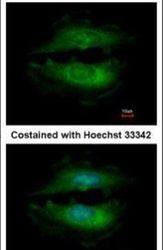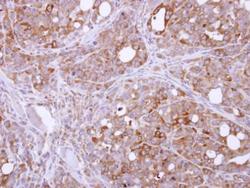Antibody data
- Antibody Data
- Antigen structure
- References [1]
- Comments [0]
- Validations
- Immunocytochemistry [1]
- Immunohistochemistry [1]
- Other assay [1]
Submit
Validation data
Reference
Comment
Report error
- Product number
- PA5-29309 - Provider product page

- Provider
- Invitrogen Antibodies
- Product name
- PASK Polyclonal Antibody
- Antibody type
- Polyclonal
- Antigen
- Recombinant full-length protein
- Description
- Recommended positive controls: mouse brain. Predicted reactivity: Mouse (91%), Rat (90%). Store product as a concentrated solution. Centrifuge briefly prior to opening the vial.
- Reactivity
- Human, Mouse
- Host
- Rabbit
- Isotype
- IgG
- Vial size
- 100 μL
- Concentration
- 1 mg/mL
- Storage
- Store at 4°C short term. For long term storage, store at -20°C, avoiding freeze/thaw cycles.
Submitted references Cell type-specific deletion in mice reveals roles for PAS kinase in insulin and glucagon production.
Semplici F, Mondragon A, Macintyre B, Madeyski-Bengston K, Persson-Kry A, Barr S, Ramne A, Marley A, McGinty J, French P, Soedling H, Yokosuka R, Gaitan J, Lang J, Migrenne-Li S, Philippe E, Herrera PL, Magnan C, da Silva Xavier G, Rutter GA
Diabetologia 2016 Sep;59(9):1938-47
Diabetologia 2016 Sep;59(9):1938-47
No comments: Submit comment
Supportive validation
- Submitted by
- Invitrogen Antibodies (provider)
- Main image

- Experimental details
- Immunofluorescent analysis of PASK in methanol-fixed HeLa cells using a PASK polyclonal antibody (Product # PA5-29309) at a 1:500 dilution.
Supportive validation
- Submitted by
- Invitrogen Antibodies (provider)
- Main image

- Experimental details
- Immunohistochemical analysis of paraffin-embedded NCIN87 xenograft, using PASK (Product # PA5-29309) antibody at 1:500 dilution. Antigen Retrieval: Citrate buffer, pH 6.0, 15 min.
Supportive validation
- Submitted by
- Invitrogen Antibodies (provider)
- Main image

- Experimental details
- Fig. 1 Generation of conditional Pask alleles and deletion in beta or alpha cells. ( a ) Knockout (KO) strategy. Generation of beta ( Pask BKO) and alpha ( Pask AKO) cell-specific Pask KO mice by Cre-mediated excision of exons from 12 to 15 encoding the PASK Ser/Thr kinase domain. Human PASK cDNA (modified from [ 22 ]) with the Ser/Thr kinase domain encoding exons circled in purple and enlarged in the black box--a view from the back of PASK kinase domain (amino acids 977-1300) crystal structure (PBD code 3DLS) with the bound ADP molecule in evidence [ 43 ]. ( b ) Mouse Pask gene structure (modified from [ 22 ]) and the location of the loxP sites. ( c ) Example of a genotyping gel indicating the presence of WT and recombined (Cond) alleles. ( d ) Pask and Ins2 gene expression measured by qPCR in Pask BKO (BKO) and control (WT) mouse islets. Immunohistochemical analysis of pancreatic sections from Pask BKO ( e ) and Pask AKO ( f ) mice and controls, with PASK revealed using Alexa 568 (red), and insulin or glucagon revealed using Alexa 488 (green). Insets i-iv are magnified areas, as shown in the main images. Insets v-viii are example images of no-primary-antibody controls for each of the genotypes, with insets v and vii showing the DAPI staining for nuclei; scale bars, 100 mum. PASK fluorescence was displayed in 87.6 +- 1.5% of insulin-positive cells in WT islets vs 10.5 +- 2.3% in Pask BKO islets; n = 7 mice per genotype for both Pask BKO and Pask AKO mice; * p < 0.05 and ** p
 Explore
Explore Validate
Validate Learn
Learn Western blot
Western blot Immunocytochemistry
Immunocytochemistry